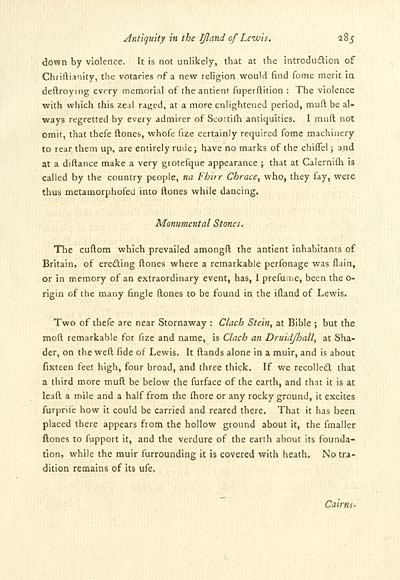Ossian Collection > Account of some remains of antiquity in the Island of Lewis, one of the Hebrides
(5)
Download files
Complete book:
Individual page:
Thumbnail gallery: Grid view | List view

Antiquity in the Ijland of Lewis. 285
dovun by violence, [t is not unlikely, that at the introdudtlon of
Chriftianity, the votaries of a nevr religion would find fome merit in
deftroymg evf^ry memorial of the antient fuperftition : The violence
with which this zeal rai!;ed, at a more enlightened period, muft be al-
ways regretted by every admirer of ScottiQi antiquities. I muft not
omit, that thefe ftones, whofe fize certainly required fomc machinery
to rear them up, are entirely rude; have no marks of the chiflel ; and
at a diftance make a very gtotefque appearance ; that at Calernifh is
called by the country people, na bhitr Chrace^ who, they fay, were
thus metamorphofed into ftones while dancing.
Monumental Stones >
The cuftom which prevailed amongft the antient inhabitants of
Britain, of ereding ftones where a remarkable perfonage was flain,
or in memory of an extraordinary event, has, 1 prefuuie, been the o-
rigin of the many fingle ftones to be found in the ifland of Lewis.
Two of thefe are near Stornaway : Clach Stein, at Bible ; but the
moft remarkable for fize and name, is Clach an Druidjloall, at Sha-
der, on the weft fide of Lewis. It ftands alone in a muir, and is about
fixteen feet high, four broad, and three thick. If we recollect that
a third more muft be below the furface of the earth, and that it is at
leaft a mile and a half from the ftiore or any rocky ground, it excites
furprii'e how it could be carried and reared there. That it has been
placed there appears from the hollow ground about it, the fmaller
ftones to fupport it, and the verdure of the earth about its founda-
tion, while the muir furrounding it is covered with heath. No tra-
dition remains of its ufe.
Cairns.
dovun by violence, [t is not unlikely, that at the introdudtlon of
Chriftianity, the votaries of a nevr religion would find fome merit in
deftroymg evf^ry memorial of the antient fuperftition : The violence
with which this zeal rai!;ed, at a more enlightened period, muft be al-
ways regretted by every admirer of ScottiQi antiquities. I muft not
omit, that thefe ftones, whofe fize certainly required fomc machinery
to rear them up, are entirely rude; have no marks of the chiflel ; and
at a diftance make a very gtotefque appearance ; that at Calernifh is
called by the country people, na bhitr Chrace^ who, they fay, were
thus metamorphofed into ftones while dancing.
Monumental Stones >
The cuftom which prevailed amongft the antient inhabitants of
Britain, of ereding ftones where a remarkable perfonage was flain,
or in memory of an extraordinary event, has, 1 prefuuie, been the o-
rigin of the many fingle ftones to be found in the ifland of Lewis.
Two of thefe are near Stornaway : Clach Stein, at Bible ; but the
moft remarkable for fize and name, is Clach an Druidjloall, at Sha-
der, on the weft fide of Lewis. It ftands alone in a muir, and is about
fixteen feet high, four broad, and three thick. If we recollect that
a third more muft be below the furface of the earth, and that it is at
leaft a mile and a half from the ftiore or any rocky ground, it excites
furprii'e how it could be carried and reared there. That it has been
placed there appears from the hollow ground about it, the fmaller
ftones to fupport it, and the verdure of the earth about its founda-
tion, while the muir furrounding it is covered with heath. No tra-
dition remains of its ufe.
Cairns.
Set display mode to: Large image | Transcription
Images and transcriptions on this page, including medium image downloads, may be used under the Creative Commons Attribution 4.0 International Licence unless otherwise stated. ![]()
| Early Gaelic Book Collections > Ossian Collection > Account of some remains of antiquity in the Island of Lewis, one of the Hebrides > (5) |
|---|
| Permanent URL | https://digital.nls.uk/78086464 |
|---|
| Description | Selected books from the Ossian Collection of 327 volumes, originally assembled by J. Norman Methven of Perth. Different editions and translations of James MacPherson's epic poem 'Ossian', some with a map of the 'Kingdom of Connor'. Also secondary material relating to Ossianic poetry and the Ossian controversy. |
|---|
| Description | Selected items from five 'Special and Named Printed Collections'. Includes books in Gaelic and other Celtic languages, works about the Gaels, their languages, literature, culture and history. |
|---|

